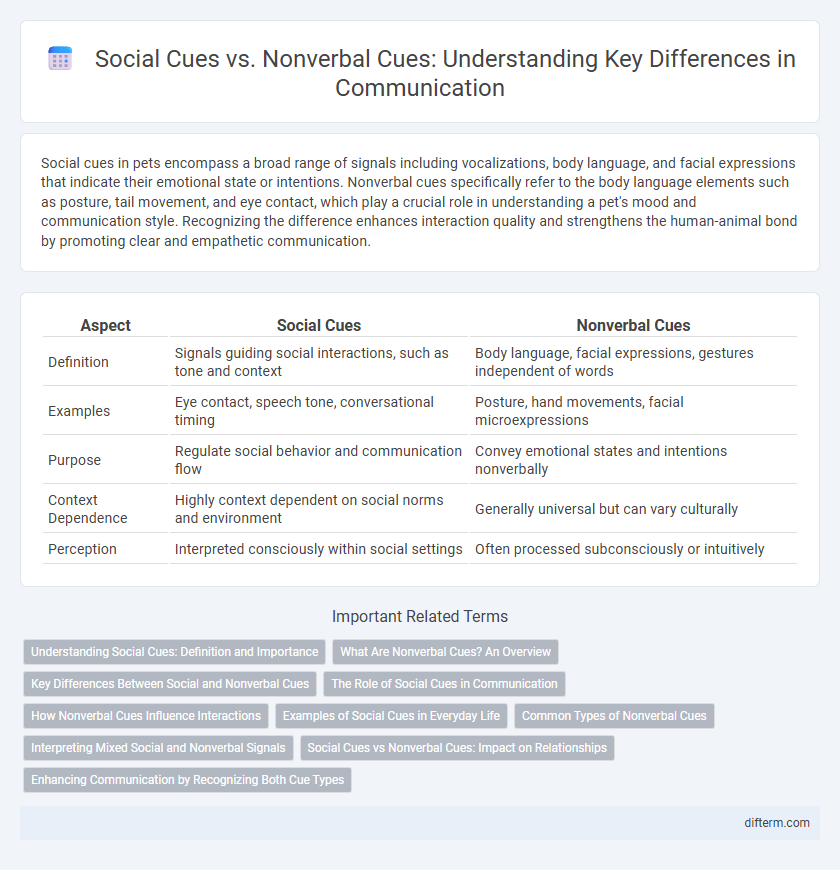Social cues in pets encompass a broad range of signals including vocalizations, body language, and facial expressions that indicate their emotional state or intentions. Nonverbal cues specifically refer to the body language elements such as posture, tail movement, and eye contact, which play a crucial role in understanding a pet's mood and communication style. Recognizing the difference enhances interaction quality and strengthens the human-animal bond by promoting clear and empathetic communication.
Table of Comparison
| Aspect | Social Cues | Nonverbal Cues |
|---|---|---|
| Definition | Signals guiding social interactions, such as tone and context | Body language, facial expressions, gestures independent of words |
| Examples | Eye contact, speech tone, conversational timing | Posture, hand movements, facial microexpressions |
| Purpose | Regulate social behavior and communication flow | Convey emotional states and intentions nonverbally |
| Context Dependence | Highly context dependent on social norms and environment | Generally universal but can vary culturally |
| Perception | Interpreted consciously within social settings | Often processed subconsciously or intuitively |
Understanding Social Cues: Definition and Importance
Social cues encompass verbal signals including tone of voice and word choice that guide interpersonal interactions, while nonverbal cues consist of body language, facial expressions, and gestures conveying emotions without spoken words. Understanding social cues is essential for effective communication, fostering empathy, and building strong relationships across diverse social contexts. Mastery of these cues enhances emotional intelligence and helps navigate complex social dynamics with greater sensitivity and awareness.
What Are Nonverbal Cues? An Overview
Nonverbal cues encompass body language, facial expressions, gestures, posture, and eye contact, serving as critical components of interpersonal communication beyond spoken words. These cues provide insight into emotions, attitudes, and social dynamics, often conveying messages more powerfully than verbal communication. Understanding nonverbal cues enhances social awareness and improves relational interactions by interpreting unspoken signals accurately.
Key Differences Between Social and Nonverbal Cues
Social cues involve contextual signals such as tone of voice, facial expressions, and body language that guide interpersonal interactions and convey emotions. Nonverbal cues are a subset, primarily including physical gestures, posture, and eye contact, which communicate information without spoken words. The key difference lies in social cues encompassing broader communicative elements influenced by situational context, while nonverbal cues specifically refer to visual and physical behaviors independent of verbal content.
The Role of Social Cues in Communication
Social cues guide interpersonal interactions by conveying emotions, intentions, and reactions through facial expressions, tone of voice, and body language. These cues help individuals interpret underlying meanings beyond spoken words, fostering empathy and understanding in social exchanges. Effective communication depends on accurately perceiving and responding to social cues to build trust and rapport.
How Nonverbal Cues Influence Interactions
Nonverbal cues such as facial expressions, gestures, and posture significantly shape social interactions by conveying emotions and intentions beyond spoken words. These cues often regulate conversations, signal empathy, and establish social hierarchies, influencing how messages are interpreted. Understanding nonverbal communication enhances social awareness and improves interpersonal relationships across diverse cultural contexts.
Examples of Social Cues in Everyday Life
Examples of social cues in everyday life include facial expressions such as smiling to indicate friendliness, maintaining eye contact to show attentiveness, and using tone of voice to convey emotions like sarcasm or enthusiasm. Body language like nodding during conversations signals agreement or understanding without verbal confirmation. Social gestures such as a handshake or waving serve as culturally recognized signals for greeting or farewell.
Common Types of Nonverbal Cues
Common types of nonverbal cues include facial expressions, gestures, posture, eye contact, and proxemics, each playing a vital role in social interactions by conveying emotions and intentions without words. Facial expressions such as smiling or frowning provide immediate emotional feedback, while gestures like waving or pointing enhance communication clarity. Understanding these cues improves social awareness and helps interpret unspoken messages effectively in various social settings.
Interpreting Mixed Social and Nonverbal Signals
Interpreting mixed social and nonverbal signals requires recognizing inconsistencies between facial expressions, body language, and spoken words to accurately assess intentions and emotions. Key indicators such as eye contact, tone of voice, and posture provide critical context for decoding ambiguous messages in social interactions. Mastery of reading these intertwined cues enhances communication effectiveness and emotional intelligence in complex social environments.
Social Cues vs Nonverbal Cues: Impact on Relationships
Social cues encompass verbal and environmental signals that guide interactions, whereas nonverbal cues primarily involve body language, facial expressions, and gestures. Understanding social cues enhances communication by providing context to spoken words, while nonverbal cues often reveal true emotions and attitudes, sometimes contradicting verbal messages. The interplay of social and nonverbal cues significantly impacts relationship dynamics, influencing trust, empathy, and conflict resolution.
Enhancing Communication by Recognizing Both Cue Types
Recognizing both social cues and nonverbal cues significantly enhances communication by providing deeper insight into emotions and intentions during interactions. Social cues, such as tone of voice and context, combined with nonverbal signals like facial expressions and body language, allow for a more accurate interpretation of messages. Mastering the ability to read these cues improves empathy, reduces misunderstandings, and fosters stronger interpersonal connections.
social cues vs nonverbal cues Infographic

 difterm.com
difterm.com